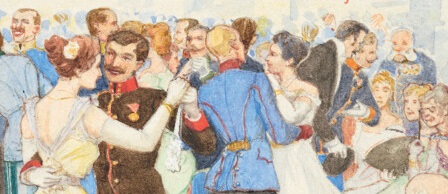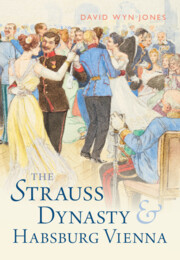
One of the most pleasant tasks facing the author of a published book is choosing an appropriate image for the cover. For a biography of one person the choice is obvious, an image of the subject. In my case it was more difficult since the book deals with four people, Johann Strauss the father and his three sons, Johann, Josef and Eduard. No group image of the four survives and for a long time I toyed with the compromise of presenting four individual images on the cover, but I was troubled by the thought that it might give the impression of four discrete biographies in one volume. This would have been fundamentally misleading. Continual interaction between the family members characterized their lives and I wanted to emphasize that collective approach to what they came to call ‘the business’, composing and directing waltzes, polkas, quadrilles and marches. Also, since surviving images of the four composers are black-and-white ones, placing them together might have given an inappropriately gloomy image, more akin to a ‘wanted poster’ than up-lifting entertainment. I then considered a more neutral approach, an attractive image of Vienna in the nineteenth century – of which there are plenty – but remained worried by the lack of a specific connection between such images and the subject matter of the book.
I then discovered a beautiful water colour painting by Anton Kapeller, a Viennese artist from the end of the nineteenth century. It shows a ballroom scene, with a nice sense of physical movement as the couples move to the swaying pattern of the waltz, 1-2-3, 1-2-3, 1-2-3, 1-2-3. On the right a group of seated ladies is approached by two male figures, either requesting a dance or, equally likely, pointing out some gossip. In the foreground, on the right, a much larger figure is seated, an elderly gentleman in military uniform who is observing the dance. Observing the dance and listening to the music, rather than participating, had always been a characteristic of balls in nineteenth-century Vienna, but this seated figure is clearly a recognizable person, Franz Joseph the Austrian emperor. In the full painting (reproduced as a frontispiece in the book) that supposition is confirmed by its title, ‘Kaiser-Walzer’, together with a callagraphic music quotation of one of its most memorable tunes. Like the emperor, the quoted music was a reality, one of the most beguiling works of the younger Johann Strauss.
The elegance of the whole and the resonances of the detail made it an ideal image for the cover. But its appeal went further. As the title of the book indicates, The Strauss Dynasty and Habsburg Vienna, I wanted to explore the relationship between the music of the Strauss family and the wider cultural, social and political environment, a relationship that spanned most of the nineteenth century. Strauss’s Kaiser-Walzer is a good example of this wider resonance and, indeed, of a certain artistic sleight of hand that often went with its creation.
To associate one Strauss, Johann (the son), with the Kaiser was entirely appropriate. He, like his father before him, and Eduard after him, was given the title of ‘Imperial-Royal Court Ball Director’, proudly displayed on title pages of his music. Many waltzes, polkas and marches by the four Strausses linked directly or indirectly into events in the imperial family, weddings, anniversaries, unveiling of monuments and, uniquely, the near catastrophe of a failed assassination attempt. But the Kaiser-Walzer was not one of these. As was often the case, titles for individual dances and marches were chosen by the publisher rather than the composer. Johann Strauss had been asked to compose a new waltz for a new concert venue in Berlin, which he provisionally named Hand in Hand, which may reflect the cordial relationship between two imperial dynasties, the Habsburg in Vienna and the Hohenzollern in Berlin. His publisher at the time, Simrock, was based in Berlin and came up with the idea of calling it the Kaiser-Walzer, which Prussians would have interpreted as their Kaiser, Wilhelm II. When the publication duly appeared it was with an image of the Austrian imperial crown, which obviously appealed to the Viennese. This imprecision, while commercially and reputationally advantageous, fed into a broader aesthetic.
Musically, the Kaiser-Walzer is not a portrait of a particular emperor, much less a narrative tale; it certainly begins with march rhythms but the work becomes increasingly less imperial as soon as the sequence of dances unfolds. The music of the four Strausses often escapes from a given title to a musical self-sufficiency, managing the paradox of being topical and timeless. One of the key qualities associated with that process was an instinctive control of musical sensibility, displayed by all four composers. The music quoted in Anton Kapeller’s painting is a perfect example of this: a couple of phrases from the beginning of the first waltz that are to be magically recalled in the final section of the work in a perfect moment of nostalgia. The title, Kaiser-Walzer, is just a cover.

Latest Comments
Have your say!